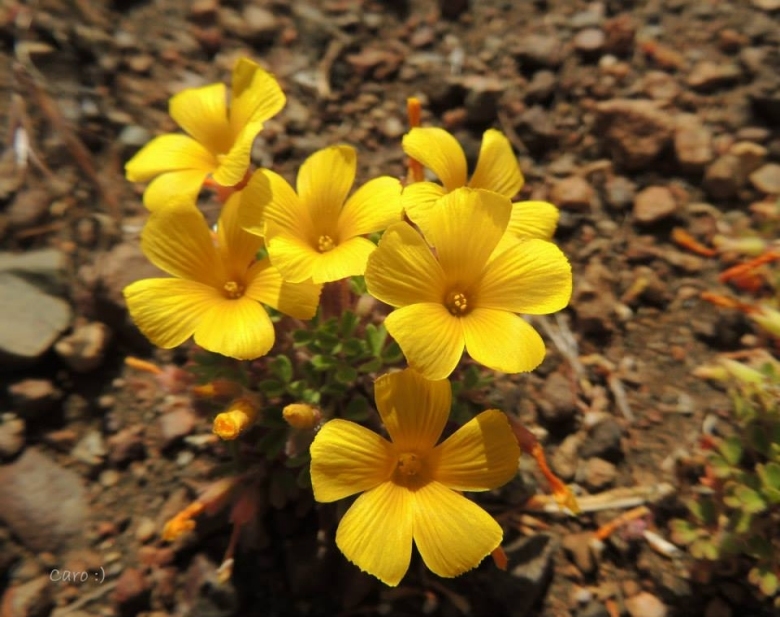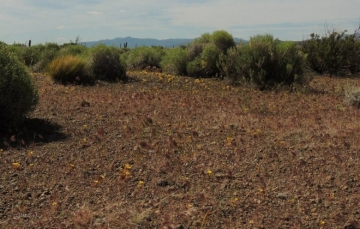Accepted Scientific Name: Oxalis nahuelhuapiensis Speg.
Anales Soc. Ci. Argent. 47: 227 1899

Oxalis comberi (Oxalis nahuelhuapiensis) Photo by: Carolina González
Flowering habit, Neuquén province, Argentina.
Origin and Habitat: Oxalis nahuelhuapiensisSN|31152]]SN|31152]] grows in the mountains of southern Chile and Argentina, from northern Andean Patagonia to the Araucanian region.
Type locality: Shady rocks by Lago Nahuel huapi, north Patagonia, Argentina.
Altitude range: 1000-2200 metres above sea level.
Habitat and ecology: This species grows in cushion steppe communities amongst bunch grass and in fields. It is often quite common where it is present.
Synonyms:
Description: Oxalis nahuelhuapiensisSN|30991]]SN|31152]] is a small yellow flowering Oxalis, related to Oxalis compactaSN|31152]]SN|30991]] but with more or less glabrous rather than hairy leaves.
Habit: Mat to cushion-forming perennial herb from a deep woody taproot, to a maximum of 15 cm tall but usually less, loose to very tight in habit, sometimes almost hard, individual plants ranging from 15 cm to 1 m in diameter.
Stems: Creeping, thick, fleshy, woolly. Cortex thick, with lax scales; these linear-triangular, produced into fine, leafless petioles.
Leaves: New branchlets from the axils of the scales are fasciculately leafy, with long slender petioles, and leaflets 3, deeply cordate, bilobed; their lobes broad, obtuse, thick, glabrous.
Inflorescences: solitary or 2(-3) flowered peduncles.
Flowers: Rather small, glabrous, hermaphrodite, actinomorphic, with differentiated sepals and petals (Calix and Corolla), 5 petals, free, five sepals, free, ovary superior, 10 stamens, united and disegual (of different lengths), 8-10 mm long, light clear yellow to yellow with red veining on the petal backs.
Blooming season: Summer.
Fruits: Capsules
Bibliography: Major references and further lectures
1) George Macloskie “Flora Patagonica” The University, 1904
2) John Bell Hatcher “Reports of the Princeton University Expeditions to Patagonia”, 1896-1899, Volume 8, page 541, Edition 1-5 University, 1901-32 [v., 1903]
3) The Alpine Garden Society “Oxalis nahuelhuapiensis” Web. 13 May 2015.
 Yellow patches of Oxalis nahuelhuapiensis in habitat. Neuquén province, Argentina (Oxalis nahuelhuapiensis) Photo by: Carolina González
Yellow patches of Oxalis nahuelhuapiensis in habitat. Neuquén province, Argentina (Oxalis nahuelhuapiensis) Photo by: Carolina GonzálezSend a photo of this plant.The gallery now contains thousands of pictures, however it is possible to do even more. We are, of course, seeking photos of species not yet shown in the gallery but not only that, we are also looking for better pictures than those already present.
Read More... Cultivation and Propagation: Oxalis is often overlooked as a garden flower because of its weed reputation. Oxalis nahuelhuapiensisSN|31152]]SN|31152]] is not a weed, but a pretty and non-invasive, long-flowering Alpine specie adaptable to rock gardens, raised beds, pot culture, and window boxes. It is certainly a beautifully delicate plant that merits cultivation. This species is often grown by alpine enthusiasts because it likes a cool summer and is a good plant for rock gardens. It goes dormant when the temperature gets too cold or too warm. Growers from areas with warm summers and cold winters notice that they only grow in the autumn when temperatures are cooler. In more mild climate such as the west coast, they grow in spring and summer. Snow cover is probably necessary for protection in climates that have long and cold winters. As long as it gets enough sun and does not sit in water in winter, it blooms beautifully.
Soil: It should be potted in a mixture of peat, sand, pumice and lava grit, and loam and protected in a cold frame. The bulbs should be planted just below the surface.
Water: Water and feed liberally only in spring till the plants bloom, but do not over water. The foliage becomes straggly and limp after a while.
Exposure: Grow it in full sun. Plants usually do not live well where the sun is not strong, but those who live where the sun in stronger may tolerate some shade. If grown indoors put this pot plant in full sun to enjoy the flowers for a few weeks. Therefore, put it in the garden straight after flowering and enjoy it as a garden plant in the following year.
Hardiness: The plant tolerates low temperatures (-30° C or less) but needs protection against winter rains, can tolerate snow cover for several weeks per year.. USDA Hardiness Zone 5 to 8. Snow cover is probably necessary for protection in climates that have long and cold winters.
Winter care: The general recommendation is that the bulbs be dug out in winter and stored dry (they rot very easily in damp terrains), although in some cases those who live in moist winter areas have been successful leaving them in the ground when grown in very well-drained and gritty soil.
Maintenance: Deadhead the flowers, this will prevent the tuber to age too soon.
Use: They make superb rock garden plants, as well as adequate for the front of a border as well as being perfect for pots and containers.
Pests and diseases: Prone to rust, slugs and snails.
Propagation: It may be propagated by offsets and by seeds. Sow them during autumn, in a mix of equal parts of compost, regular garden soil and sharp river sand. Cover this mix with a layer of sand, distribute the seeds and spread some more sand over them to barely cover the seeds. Place your sowing pan in a cold frame or cold greenhouse if you have heavy rain in your area. If you have snow, place the sowing pan outdoors and let nature do its work. The seedlings can be transplanted once they are 5 cm tall. These pretty plants can bloom the first year grown from seeds, but will display their best from the second year on.











